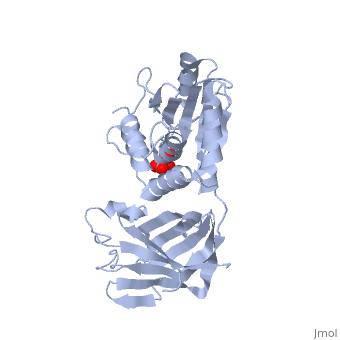PTEN: Difference between revisions
Nathan Line (talk | contribs) No edit summary |
Nathan Line (talk | contribs) No edit summary |
||
| Line 13: | Line 13: | ||
PTEN is a tumor suppressor protein that is mutated in several human cancers. These include glioblastomas, endometrial carcinomas, prostate carcinomas, and melanoma cases. PTEN has 403 amino acids which are separated into <scene name='Nathan_Line_sandbox/Structure/6'>two domains.</scene> The red section represents the C2 domain which allows the protein to bind with phospholipid membrane. The phosphatase section (blue) interacts with the ligand and the phosphate head. These interactions are controled by two separate loops. The <scene name='Nathan_Line_sandbox/Actice_site/1'>P-loop</scene> is responsible for the catalytic reactions performed by the protein. These reactions are what halt cell growth. The P-loop is made up of two parts, the catalytic parts (green) that perform the reactions and the conformational parts (purple) that force the loop into its conformational shape. The other loop is the <scene name='Nathan_Line_sandbox/Structure/5'>"TI" loop.</scene> This loop interacts with the lipid while in the active P-loop to increase the catalysis. | PTEN is a tumor suppressor protein that is mutated in several human cancers. These include glioblastomas, endometrial carcinomas, prostate carcinomas, and melanoma cases. PTEN has 403 amino acids which are separated into <scene name='Nathan_Line_sandbox/Structure/6'>two domains.</scene> The red section represents the C2 domain which allows the protein to bind with phospholipid membrane. The phosphatase section (blue) interacts with the ligand and the phosphate head. These interactions are controled by two separate loops. The <scene name='Nathan_Line_sandbox/Actice_site/1'>P-loop</scene> is responsible for the catalytic reactions performed by the protein. These reactions are what halt cell growth. The P-loop is made up of two parts, the catalytic parts (green) that perform the reactions and the conformational parts (purple) that force the loop into its conformational shape. The other loop is the <scene name='Nathan_Line_sandbox/Structure/5'>"TI" loop.</scene> This loop interacts with the lipid while in the active P-loop to increase the catalysis. | ||
<scene name='Nathan_Line_sandbox/P_mutations/1'> | Mutations of PTEN occur within of the these different areas of the protein. The P-loop itself contains three mutations all of which decrease the protein's activity. This results in excessive cells growth and tumors. The amino acid mutated in the loop are <scene name='Nathan_Line_sandbox/P_mutations/1'>Lys125, Lys128, and His123.</scene> | ||
<scene name='Nathan_Line_sandbox/Ti_mutations/1'>TextToBeDisplayed</scene> | <scene name='Nathan_Line_sandbox/Ti_mutations/1'>TextToBeDisplayed</scene> | ||
Revision as of 01:02, 6 October 2009
This is a placeholderThis is a placeholder
This is a placeholder text to help you get started in placing a Jmol applet on your page. At any time, click "Show Preview" at the bottom of this page to see how it goes.
Replace the PDB id (use lowercase!) after the STRUCTURE_ and after PDB= to load and display another structure.
MUTATIONS OF PTEN IN CANCERMUTATIONS OF PTEN IN CANCER
PTEN is a tumor suppressor protein that is mutated in several human cancers. These include glioblastomas, endometrial carcinomas, prostate carcinomas, and melanoma cases. PTEN has 403 amino acids which are separated into The red section represents the C2 domain which allows the protein to bind with phospholipid membrane. The phosphatase section (blue) interacts with the ligand and the phosphate head. These interactions are controled by two separate loops. The is responsible for the catalytic reactions performed by the protein. These reactions are what halt cell growth. The P-loop is made up of two parts, the catalytic parts (green) that perform the reactions and the conformational parts (purple) that force the loop into its conformational shape. The other loop is the This loop interacts with the lipid while in the active P-loop to increase the catalysis.
Mutations of PTEN occur within of the these different areas of the protein. The P-loop itself contains three mutations all of which decrease the protein's activity. This results in excessive cells growth and tumors. The amino acid mutated in the loop are

